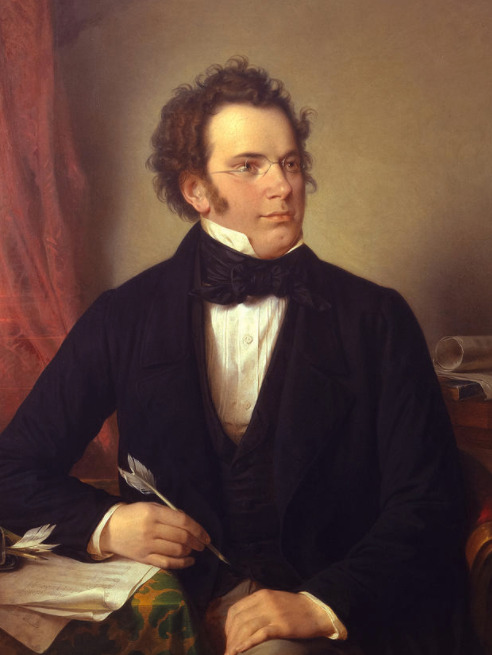Franz Schubert (1797-1828) was an Austrian composer known for his Romantic music. He is considered to be one of the greatest composers in the Western classical tradition and a forerunner of Romanticism. His works include the famous Ave Maria, the Trout Quintet, Die Forelle and Erlkönig, among many others. Schubert composed over 600 songs and more than 200 chamber and orchestral works during his short life. His symphonies have been praised for their innovative orchestrations, while his piano sonatas are known for their lyrical melodies and youthful freshness. He also wrote hundreds of art songs, lieder, operas, string quartets and masses. During his lifetime he was largely unrecognized as a composer but he is now widely celebrated as one of the world’s most important musicians who greatly impacted musical composition.
Schubert was a genius who wrote over 600 works and managed to leave a lasting impression on the world of classical music. He wrote in many different genres, from operas to symphonies, sonatas to chamber music, and art songs to sacred works.
What really made Schubert unique was his ability to write music that sounded like it was composed in the moment, even though it was carefully crafted and had an intricate structure. His melodies were often simple but beautiful, with unexpected turns and twists that made them captivating.
Early Life and Education of Schubert
Born in Vienna to a musical family, Franz Schubert was a child prodigy. From a young age, he displayed an extraordinary talent for composition and was accepted into the Imperial Court Chapel Choir when he was only 11 years old. He received his formal education at the Stadtkonvikt school, where he studied music theory and counterpoint with Antonio Salieri and Anton Hüttenbrenner.
Schubert went on to become one of the most influential composers of early Romanticism. His works encompassed numerous genres, including symphonies, masses, operas, chamber music, art songs, and Liebeslieder (love songs). In addition, Schubert wrote some 600 Lieder (songs) — more than any other classical composer — all of which showcase his genius for merging poetic texts into complex musical structures. These compositions have become keystones in a classical music repertoire that still speaks to today’s listeners.
His Unique Sound and Structural Techniques
Franz Schubert’s innovation was an inventive way of connecting mood and form. His masterful use of unusual rhythms, startling harmonic turns, and boldness in exploring modulation all gave his work an unparalleled character. An intense lyricism defined his works, whether it be a sonata or song.
The combination of Schubert’s compositional elements created a musical language that was truly distinct. His introduction of aspects such as the “schubertiade” (a chamber music gathering) and devising new structural techniques—such as combining parts of larger forms into symphonic movements—led to experimentation that broke standard conventions.
At the same time, Schubert wrote with remarkable economy; his works managed to make powerful statements with just a few notes. He used harmony to its fullest potential, often blending together chromaticism and dissonance for expressive effect. All these elements contributed to Schubert’s unique musical style, making him one of the most influential composers in history.
Notable Symphonies Composed by Schubert
As one of the most influential composers of the romantic period, Franz Schubert is remembered for his stunning symphonies. These works were both innovative and extremely influential on later generations of composers. Most notably, Schubert’s Symphony No. 8 in B minor (the “Unfinished”) and Symphony No. 9 in C major (the “Great”) are some of his greatest achievements in the realm of symphonie music.
The “Unfinished” Symphony was only partially completed with two movements when Schubert died. Despite its incomplete status, it is still highly regarded and has been performed many times since its premier in 1865. It is characterized by its lyrical melodies and a wide range of moods from somber to joyous.
On the other hand, his “Great” Symphony was composed and premiered shortly before his death in 1828. This work includes four movements that display Schubert’s unique melodic flair as well as a powerful harmonic structure coupled with intricate counterpoint techniques that have been studied by modern-day scholars for years. This symphony also captures many different emotions, ranging from delight to despair, in a way that few other compositions do.
His Contributions to ‘Lieder’ Songwriting
Franz Schubert is renowned for his contributions to the art form of ‘Lieder’, or art songs. He wrote hundreds of these pieces, drawing influences from German poetry, with many going on to become popular classical tunes.
Schubert was particularly innovative in his approach to using rhythm when writing songs. He broke with convention by adding elements such as syncopation and rubato, creating a unique sound and adding an emotional resonance that has attracted listeners ever since.
In addition to rhythm, Schubert also experimented with song structure by adding contrasting sections as well as creating longer works than were previously seen in the genre. He also had a particular flair for consonance and dissonance, creating harmonic tensions that add a further level of drama and emotion in his music.
This innovative approach still resonates today, with many modern composers citing Schubert as a source of inspiration for their own works. His contributions to Lieder songwriting have had an undeniable impact on classical music and have firmly placed him among the pantheon of great composers.
Influence of Franz Schubert on Modern Music
Franz Schubert’s innovative style continues to influence modern music to this day. His unique melodies and harmonic progressions have left an indelible mark on a wide range of genres, from classical to pop.
Traditionalism
His works were firmly rooted in the traditional literary and musical styles of the Vienna Classicism era, which is evidenced in his use of strict forms, such as sonata, variations and fugue. This helped Schubert to create highly structured works with a timeless quality.
Innovation
At the same time, Schubert was not afraid to experiment with previously unheard sounds and complex tonal structures. He pioneered many techniques like chromaticism, modulations and tonal transitions which laid the groundwork for later composers in the Romantic period.
Evolving Genres
Schubert’s music shifted between genres throughout his career, and he was one of the first composers to successfully combine elements from multiple musical traditions into one piece. This included such innovations as combining traditional Italian opera with German lieder or Viennese waltzes with symphonies, forging new pathways for later composers to follow.
Franz Schubert’s innovative music made an indelible mark in the world of classical music, and his works remain some of the most beloved and performed pieces to this day. His groundbreaking compositions bridged the divide between Classical and Romantic music, paving the way for 19th century composers. From the emotionally-laden lieder to the energetic symphonies, Franz Schubert’s music is filled with beauty, passion and depth that continues to captivate audiences today. With this essential guide, you can explore and discover the innovative music of this remarkable composer and its lasting legacy in the world of classical music.























